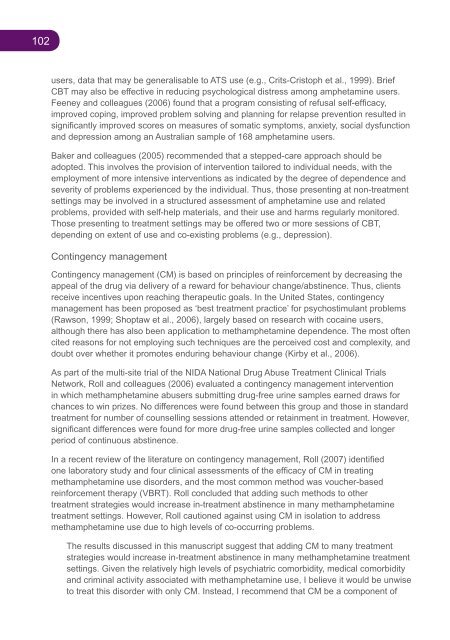National Amphetamine-Type Stimulant Strategy Background Paper
National Amphetamine-Type Stimulant Strategy Background Paper
National Amphetamine-Type Stimulant Strategy Background Paper
You also want an ePaper? Increase the reach of your titles
YUMPU automatically turns print PDFs into web optimized ePapers that Google loves.
102<br />
users, data that may be generalisable to ATS use (e.g., Crits-Cristoph et al., 1999). Brief<br />
CBT may also be effective in reducing psychological distress among amphetamine users.<br />
Feeney and colleagues (2006) found that a program consisting of refusal self-efficacy,<br />
improved coping, improved problem solving and planning for relapse prevention resulted in<br />
significantly improved scores on measures of somatic symptoms, anxiety, social dysfunction<br />
and depression among an Australian sample of 168 amphetamine users.<br />
Baker and colleagues (2005) recommended that a stepped-care approach should be<br />
adopted. This involves the provision of intervention tailored to individual needs, with the<br />
employment of more intensive interventions as indicated by the degree of dependence and<br />
severity of problems experienced by the individual. Thus, those presenting at non-treatment<br />
settings may be involved in a structured assessment of amphetamine use and related<br />
problems, provided with self-help materials, and their use and harms regularly monitored.<br />
Those presenting to treatment settings may be offered two or more sessions of CBT,<br />
depending on extent of use and co-existing problems (e.g., depression).<br />
Contingency management<br />
Contingency management (CM) is based on principles of reinforcement by decreasing the<br />
appeal of the drug via delivery of a reward for behaviour change/abstinence. Thus, clients<br />
receive incentives upon reaching therapeutic goals. In the United States, contingency<br />
management has been proposed as ‘best treatment practice’ for psychostimulant problems<br />
(Rawson, 1999; Shoptaw et al., 2006), largely based on research with cocaine users,<br />
although there has also been application to methamphetamine dependence. The most often<br />
cited reasons for not employing such techniques are the perceived cost and complexity, and<br />
doubt over whether it promotes enduring behaviour change (Kirby et al., 2006).<br />
As part of the multi-site trial of the NIDA <strong>National</strong> Drug Abuse Treatment Clinical Trials<br />
Network, Roll and colleagues (2006) evaluated a contingency management intervention<br />
in which methamphetamine abusers submitting drug-free urine samples earned draws for<br />
chances to win prizes. No differences were found between this group and those in standard<br />
treatment for number of counselling sessions attended or retainment in treatment. However,<br />
significant differences were found for more drug-free urine samples collected and longer<br />
period of continuous abstinence.<br />
In a recent review of the literature on contingency management, Roll (2007) identified<br />
one laboratory study and four clinical assessments of the efficacy of CM in treating<br />
methamphetamine use disorders, and the most common method was voucher-based<br />
reinforcement therapy (VBRT). Roll concluded that adding such methods to other<br />
treatment strategies would increase in-treatment abstinence in many methamphetamine<br />
treatment settings. However, Roll cautioned against using CM in isolation to address<br />
methamphetamine use due to high levels of co-occurring problems.<br />
The results discussed in this manuscript suggest that adding CM to many treatment<br />
strategies would increase in-treatment abstinence in many methamphetamine treatment<br />
settings. Given the relatively high levels of psychiatric comorbidity, medical comorbidity<br />
and criminal activity associated with methamphetamine use, I believe it would be unwise<br />
to treat this disorder with only CM. Instead, I recommend that CM be a component of

















